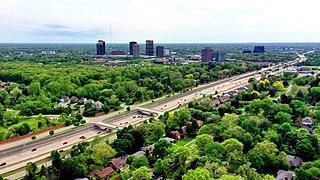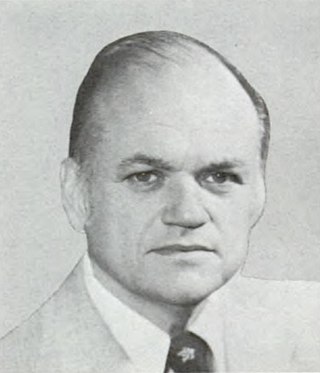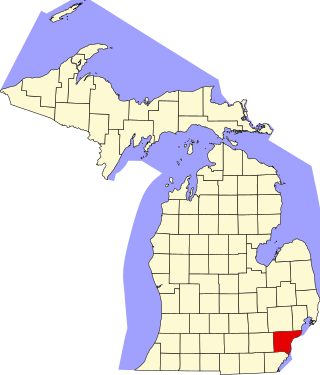List of members representing the district
Source: [11]
| Michigan's 14th congressional district | |
|---|---|
| Obsolete district | |
| Created | 1930 |
| Eliminated | 2020 |
| Years active | 1933–2023 |
Michigan's 14th congressional district was a congressional district that stretched from eastern Detroit westward to Farmington Hills, then north to the suburb of Pontiac. From 1993 to 2013, it was based entirely in Wayne County.
It was last represented by Brenda Lawrence. [1]
According to Michigan's law on redistricting, the highest numbered district must be in the southeast corner of the state. However, despite being the highest numbered district, the 14th district was not in the southeast corner of the state during its final decade of existence; the 7th district was. [2]
After the 2020 U.S. census, Michigan's 14th district was removed in the 2020 United States redistricting cycle. [3]
The district became obsolete, after the 2022 United States House of Representatives elections, as Michigan lost one district, due to reapportionment after the 2020 United States census. [4]
| Year | Office | Results |
|---|---|---|
| 1992 | President | Clinton 80%–15% |
| 1996 | President | Clinton 86%–11% |
| 2000 | President | Gore 81%–18% |
| 2004 | President | Kerry 83%–17% |
| 2008 | President | Obama 86%–14% |
| 2012 | President | Obama 81%–19% |
| 2016 | President | Clinton 79%–18% |
| 2020 | President | Biden 80%–20% |
In the 1960s, the 14th congressional district consisted of Hamtramck, the northeast portion of Detroit, Harper Woods and the Grosse Pointes. The 1964 redistricting that created these boundaries placed Lucien Nedzi, who had represented the old 14th district, in the same congressional district as fellow Democratic incumbent Harold Ryan. Nedzi was the more liberal of the two Democrats, and won the primary. In the 1972 redistricting, East Detroit and Warren south of 10 Mile Road were added to the district while some of the district in Detroit was moved to other districts. Prior to the 1972 redistricting, the majority of voters in the district were residents of Detroit. The 1972 redistricting changed the district from having a population based on the 1970 census that was 10% African American to one that was 3% African American, what with 70,000 or more residents added from East Detroit and Warren, with the latter city as a place where black families could in 1970 literally be counted with one's fingers.
At the same time, the percentage of people who were either immigrants or had at least one parent who was an immigrant fell from 46% to 37%. This was more a reflection of the fact that the residents of Warren and East Detroit at the time were in many cases literally the children and grandchildren of the residents of north-east Detroit and Hamtramck. Those born in Poland or with at least one parent born there fell from 12% to 9% of the population, the same group for Canadians fell from 7% to 6% the Italian group held steady at 6% while the German group actually rose from 4% to 6%. Since all these figures are based on the 1970 census, the changes reflect differences between the areas added and dropped, not any population movement. Based on the 1970 census, the district had the most people who identified having Belgian ancestry of any congressional district in the country, and one of the most heavily Polish as well. Based on the 1970 census, it was possible to write that Hamtramck was "an almost entirely Polish-American city". [6]
From 1982 until the 1992 redistricting, the 14th congressional district included the northeast Detroit (basically north of 6 mile and east of Ryan), Grosse Pointe Farms, Grosse Point Woods, Grosse Pointe Shores, Hamtramck, Harper Woods, the southern third of St. Clair Shores, Eastpointe, Center Line, Warren south of 10 mile and west of Van Dyke, all of Sterling Heights, Utica, Hazel Park, Madison Heights, and Troy south of about Big Beaver Road, and west of Rochester Road. [7] The district was represented by Dennis Hertel.
Conyers' 1st district included Highland Park, and Detroit between the Southfield Freeway and a line running from the south end of Highland Park over to the boundary with Dearborn. The eastern boundary of the district was with the 14th district and the northern boundary was 8 mile road.
All of the Wayne County portion of the 14th was retained in the 14th in the 1992 redistricting. It also retained most of the district area in Detroit from Conyers' old 1st district and all of Highland Park. In addition, it took in the far north-western part of Detroit and Redford Township from the 17th district, which prior to redistricting was represented by Sander Levin, and after 1992 did not exist (since there were only 16 districts). The south end of St. Clair Shores and about 80% of Eastpointe were put in the district that ended up being David Bonior's district, while the rest of Eastpointe, as well as the remaining areas in Warren, Center Line, Maidson Heights, Hazel Park, Sterling Heights, Utica and Troy were merged into the district that ended up represented by the 17th district's representative Sander Levin, renumbered as the 12th post-redistricting.
The change over time in the congressional district can be seen by what has happened in the one place that has remained constantly in the district since the 1960s, Hamtramck. Hamtramck is no longer a mainly Polish city. 20% of the population is East Indian or Bangladeshi, 19% is black or African American, and almost five percent reports multiple races. Of the 53% that is "white" according to the broad definition used by the Census Bureau, Albanians are the most numerous sub-group, with large numbers of Yemenis and Bosnians as well. It is possible that close to half the population is Muslim. [8]
The percentage of African Americans in the 2010 boundaries of the district had fallen from 61% to 59% between censuses, largely as a result of growth in the Arab population in Dearborn, combined with migration into Macomb and Oakland counties, as well as migration to Macomb, Oakland and suburban Wayne County, as well as out of Michigan entirely, from the Detroit and Highland Park portions of the district. Even the white population (including the large Arab populations in Hamtramck and Dearborn among others that rarely self-identify as white and clearly see themselves as distinct ethnic groups) within the district boundaries had declines by just over 23,000. At the same time those groups that were grouped under the heading "Asia" by the census saw their population in the district boundaries rise by a net of 2,000 during the 2010s, largely fueled by the growth of the Bangladeshi population in Hamtramck. [9]
After the 2010 census, the 14th was reconfigured to take in much of eastern Detroit and the Grosse Pointes. It was also pushed westward into Oakland County to include Southfield, Farmington Hills and Pontiac. For all intents and purposes, this was the successor to the old 13th district. Meanwhile, most of the old 14th became the new 13th.
The 13th's freshman congressman, Hansen Clarke, had his home drawn into the new 13th, but opted to follow most of his constituents into the new 14th. In the Democratic primary for this hybrid urban-suburban district, Clarke faced fellow congressman Gary Peters, whose 9th district had been eliminated in redistricting, as well as Southfield mayor Brenda Lawrence and two other Democrats. Preliminary reports showed Peters, who had previously represented part of the Oakland County portion of the district, winning with 47% of the vote to Clarke's 35% and Lawrence's 13%. [10]
Source: [11]
| Party | Candidate | Votes | % | |
|---|---|---|---|---|
| Democratic | Gary Peters (incumbent) | 270,450 | 82.3 | |
| Republican | John Hauler | 51,395 | 15.6 | |
| Libertarian | Leonard Schwartz | 3,968 | 1.2 | |
| Green | Douglas Campbell | 2,979 | 0.9 | |
| Total votes | 328,792 | 100.0 | ||
| Democratic hold | ||||
| Party | Candidate | Votes | % | |
|---|---|---|---|---|
| Democratic | Brenda Lawrence | 165,272 | 77.8 | |
| Republican | Christina Barr | 41,801 | 19.7 | |
| Libertarian | Leonard Schwartz | 3,366 | 1.6 | |
| Green | Stephen Boyle | 1,999 | 0.9 | |
| Independent | Calvin Pruden (write-in) | 30 | 0.0 | |
| Total votes | 212,468 | 100.0 | ||
| Democratic hold | ||||
| Party | Candidate | Votes | % | |
|---|---|---|---|---|
| Democratic | Brenda Lawrence (incumbent) | 244,135 | 78.5 | |
| Republican | Howard Klausner | 58,103 | 18.7 | |
| Libertarian | Gregory Creswell | 4,893 | 1.6 | |
| Green | Marcia Squier | 3,843 | 1.2 | |
| Total votes | 310,974 | 100.0 | ||
| Democratic hold | ||||
| Party | Candidate | Votes | % | |
|---|---|---|---|---|
| Democratic | Brenda Lawrence (incumbent) | 214,334 | 80.9 | |
| Republican | Marc Herschfus | 45,899 | 17.3 | |
| Working Class | Philip Kolodny | 4,761 | 1.8 | |
| Total votes | 264,994 | 100.0 | ||
| Democratic hold | ||||
| Party | Candidate | Votes | % | |
|---|---|---|---|---|
| Democratic | Brenda Lawrence (incumbent) | 271,370 | 79.3 | |
| Republican | Robert Patrick | 62,664 | 18.3 | |
| Libertarian | Lisa Lane Gioia | 3,737 | 1.1 | |
| Working Class | Philip Kolody | 2,534 | 0.7 | |
| Green | Clyde Shabazz | 1,998 | 0.6 | |
| Total votes | 342,303 | 100.0 | ||
| Democratic hold | ||||



Wayne County is the most populous county in the U.S. state of Michigan. As of 2020, the United States Census placed its population at 1,793,561, making it the 19th-most populous county in the United States. The county seat is Detroit. The county was founded in 1796 and organized in 1815. Wayne County is included in the Detroit-Warren-Dearborn, MI Metropolitan Statistical Area. It is one of several U.S. counties named after Revolutionary War-era general Anthony Wayne.

Oakland County is a county in the U.S. state of Michigan. It is a principal county of the Detroit metropolitan area, containing the bulk of Detroit's northern suburbs. Its county seat is Pontiac, and its largest city is Troy. As of the 2020 Census, its population was 1,274,395, making it the second-most populous county in Michigan, and the largest county in the United States without a city of 100,000 residents.

Macomb County is a county located in the eastern portion of the U.S. state of Michigan, bordering Lake St. Clair, and is part of northern Metro Detroit. As of the 2020 Census, the population was 881,217, making it the third-most populous county in the state. The county seat is Mt. Clemens. Macomb County is part of the Detroit-Warren-Dearborn, MI Metropolitan Statistical Area. The city of Detroit is located on the county's southern border. Macomb County contains 27 cities, townships and villages, including three of the top ten most-populous municipalities in Michigan as of the 2020 census: Warren (#3), Sterling Heights (#4) and Clinton Township (#8). Most of this population is concentrated south of Hall Road (M-59), one of the county's main thoroughfares.

Harper Woods is a city in Wayne County in the U.S. state of Michigan. An inner ring suburb of Detroit, Harper Woods borders Detroit to the north and east, roughly 9 miles (14.5 km) northeast of downtown Detroit. As of the 2020 census, the city had a population of 15,492.

Metro Detroit is a major metropolitan area in the U.S. state of Michigan, consisting of the city of Detroit and over 200 municipalities in the surrounding area with its largest employer being Oakland County. There are varied definitions of the area, including the official statistical areas designated by the Office of Management and Budget, a federal agency of the United States.

Sander Martin Levin is an American politician who served in the United States House of Representatives from 1983 to 2019, representing Michigan's 9th congressional district. Levin, a member of the Democratic Party from Michigan, is a former ranking member on the House Ways and Means Committee; he was Chairman of the Ways and Means Committee from 2010 to 2011. He was the older brother of former U.S. Senator Carl Levin, and is the father of former Congressman Andy Levin, his successor.

Lucien Norbert Nedzi is an American attorney and politician who served ten terms as a member of the United States House of Representatives from 1961 to 1981.
Michigan's 13th congressional district is a United States congressional district in Wayne County, Michigan. It is currently represented by Democrat Shri Thanedar.

This is a list of the National Register of Historic Places listings in Wayne County, Michigan.
Michigan's 10th congressional district is a United States congressional district in the Lower Peninsula of Michigan. It consists of southern Macomb County, Rochester and Rochester Hills in Oakland County.
Michigan's 11th congressional district is a United States congressional district north of Detroit, comprising most of urbanized central Oakland County. Until 1993, the district covered the state's Upper Peninsula and the northernmost portion of the Lower Peninsula. In redistricting that year, it was shifted to the outer Detroit area. Its former geographical area is now the state's first district. Its current configuration dates from 2023.
Michigan's 12th congressional district is a U.S. congressional district in Michigan.
Michigan's 7th congressional district is a United States congressional district in Southern Michigan and portions of Central Michigan. From 2004 to 2013 it consisted of all of Branch, Eaton, Hillsdale, Jackson, and Lenawee counties, and included most of Calhoun and a large portion of western and northern Washtenaw counties. The current district, which was created in 2022, is centered around Lansing, Michigan's state capital, and includes all of Clinton, Shiawassee, Ingham, and Livingston counties, as well as portions of Eaton and Oakland counties.
Michigan's 17th congressional district is an obsolete United States congressional district in Michigan. The first Representative to Congress elected from the 17th district, George Anthony Dondero, took office in 1933, after reapportionment due to the 1930 census. The district was dissolved following the 1990 census. The last Representative elected from the district, Sander M. Levin, was subsequently elected from the 12th district.
Michigan's 6th congressional district is a United States congressional district in southeast Michigan. In 2022, the district was redrawn to be centered around Ann Arbor and Washtenaw County, as well as western and southern Wayne County, small part of southwestern Oakland County, and the city of Milan in Monroe County. In previous redistrictings, the 6th district consisted of all of Berrien, Cass, Kalamazoo, St. Joseph, and Van Buren, counties, and includes most of Allegan county.

Brenda Lawrence is an American politician who served as the U.S. representative from Michigan's 14th congressional district from 2015 to 2023. A member of the Democratic Party, Lawrence served as mayor of Southfield, Michigan, from 2001 to 2015, and was the party's nominee for Oakland County executive in 2008 and for lieutenant governor in 2010. Her district covers most of eastern Detroit, including downtown, and stretches west to take in portions of Oakland County, including Farmington Hills, Pontiac, and Lawrence's home in Southfield.
As of the census of 2010, there were 5,196,250 people, 1,682,111 households, and 1,110,454 families residing within the Detroit–Warren–Ann Arbor Combined Statistical Area. Within the Detroit–Warren–Dearborn Metropolitan Statistical Area, there were 4,296,250 people residing. The census reported 70.1% White, 22.8% African-American, 0.3% Native American, 3.3% Asian, 0.02% Pacific Islander, 1.2% from other races, and 2.2% from two or more races. Hispanic or Latino of any race were 6.2% of the population. Arab Americans were at least 4.7% of the region's population.

In 2004, Metro Detroit had one of the largest settlements of Middle Eastern people, including Arabs and Chaldo-Assyrians in the United States. As of 2007 about 300,000 people in Southeast Michigan traced their descent from the Middle East. Dearborn's sizeable Arab community consists largely of Lebanese people who immigrated for jobs in the auto industry in the 1920s, and of more recent Yemenis and Iraqis. In 2010 the four Metro Detroit counties had at least 200,000 people of Middle Eastern origin. Bobby Ghosh of TIME said that some estimates gave much larger numbers. From 1990 to 2000 the percentage of people speaking Arabic in the home increased by 106% in Wayne County, 99.5% in Macomb County, and 41% in Oakland County.

Metro Detroit has the following ethnic groups: